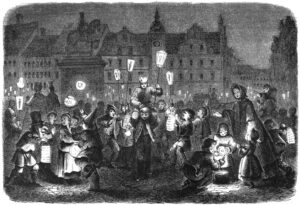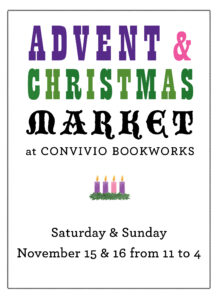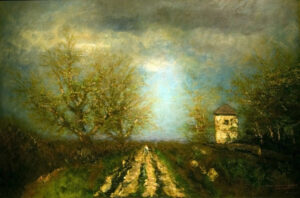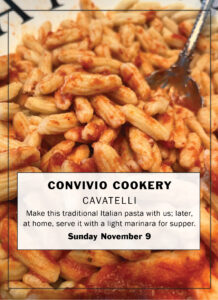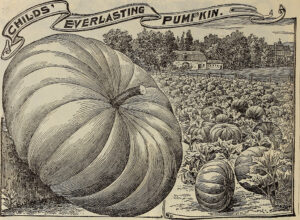Hallowe’en each year ushers in a span of time known as Hollantide; we’ve been in the midst of it since, and here, with Martinmas, Hollantide comes to a close. This is the time when we traditionally remember our dead. All Hallows (All Saints Day) is what gives the span its name––Hollantide being but a corruption of the word Hallowtide. It is the time of the sacred, the time of the holy, the time of remembrance.
Martinmas celebrates St. Martin of Tours. He was a Roman military veteran (and lo, today also brings Veterans Day and Armistice Day) in the fourth century who opted to take up Christian pacifism and is known best for helping a poor, drunken man on a cold winter’s day by tearing his own cloak in two so that the poor fellow would have something to keep himself warm. St. Martin has since become a patron saint of tailors, vineyard keepers, winemakers, and drinkers. In Germany tonight, children will parade through villages carrying Martinmas lanterns that they’ve made, illuminating the night.
So, what is it that makes Martinmas the bookend to Hallowe’en? The connection may have something to do with the Celtic New Year––Samhain––which, over the centuries, melded and evolved into the Hallowe’en celebrations we know today. Samhain marks, as well, in traditional reckoning of time, the transition to winter. With all of these November days since Samhain, since Hallowe’en, our thoughts have gone deeper below the earth, just as the natural world also shifts its energy below the earth. Winter leads us there. The legend of Persephone leads us there. The trees take us there: The leaves have flown, all growth now is below, in the roots. This makes for stronger growth above ground come spring and summer: balance. As above, so below. Oh and guess what? November 11 is the old style date of Samhain. Winter, by the almanac, is still several weeks away, but by traditional reckoning of time, it is Martinmas that marks its full onset… so that by the solstice, we’ll be singing songs like “In the Bleak Midwinter.” This is the shift that comes with Martinmas.
It is, as well, the day when new young wines are tasted: it is time, for instance, for the new Beaujolais vintage to be released. All signs point toward harvest and gathering in, and in the gathering darkness, the lanterns of Martinmas brighten the early nightfall. The shift toward winter is now undeniable.
IT’S TIME FOR ADVENT CANDLES & CALENDARS!
These lovely traditions help to slow things down on the approach to Christmas and help us welcome Christmas in its own time. (This is what we mean when we talk about celebrating a Slow Christmas.) Our Advent Calendars are all made in Germany (a few are made in England) and our Advent Candles are all made in Germany, England, Sweden… and, new this year, we have handmade beeswax Advent Candles made for us by a small company in Atlanta. CLICK HERE to shop our Advent offerings.
COME SEE US!
We enter into a very busy time of year for us, and here’s a listing of the in-shop events and pop-up markets we currently have on our calendar:
Our first Advent & Christmas Market of the season is happening this weekend at the shop: Saturday November 15 & Sunday November 16 from 11 to 4. Enjoy homemade Christmas cookies and our own Löfbergs Swedish Coffee while you shop. (Our second Advent & Christmas Market is planned for Thanksgiving Weekend: Friday November 28, Saturday November 29, and Sunday November 30.) The shop is at 1110 North G Street in Lake Worth Beach, Florida.
Find us on Friday November 21, Saturday November 22, and Sunday November 23 at the Scandinavian Christmas Market in Lantana; then on Saturday December 6 at Christmas Market Miami at the German American Social Club in Miami (that’s us and our pop-up shop in the photo!); and at Krampusnacht on Friday night December 12 and Christkindlmarkt on Saturday December 13 and Sunday December 14, all at the American German Club in Lake Worth. And we’ll reopen the shop again for our Solstice Market on Saturday & Sunday, December 20 & 21.
Image: “Martinmas in Düsseldorf ” (Das Martinsfest in Düsseldorf) by Otto von Reinsberg-Düringsfeld. Engraving, 1863 [Public domain, via Wikimedia Commons].
